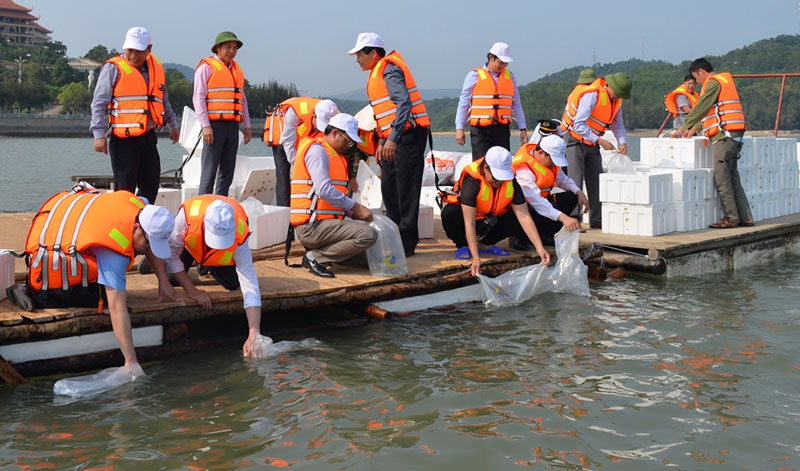Approval of the National Program for the Protection and Development of Fisheries Resources until 2030 in Vietnam
What are the regulations on the National Program for the Protection and Development of Fisheries Resources until 2030 in Vietnam approved by the Prime Minister?

Approval of the National Program for the Protection and Development of Fisheries Resources until 2030 in Vietnam (Internet image)
The content of the National Program for the Protection and Development of Fisheries Resources until 2030
The Prime Minister issued Decision 76/QD-TTg in 2024, approving the National Program for the Protection and Development of Fisheries Resources until 2030.
The content of the National Program for the Protection and Development of Fisheries Resources until 2030 includes:
1. Surveying and assessing fisheries resources and the living environment of aquatic species
- Conducting an overall survey of fisheries resources and the living environment of aquatic species until 2030, in accordance with Decision 523/QD-TTg in 2022 by the Prime Minister.
- Carrying out surveys and assessments of fisheries resources and the living environment of aquatic species according to specific requirements of ministries, sectors, and localities.
- Improving and updating the component database on the protection and development of fisheries resources under the national fisheries database; updating information and publishing the results of surveys on fisheries resources and the living environment of aquatic species.
2. Marine conservation in Vietnam
- Reviewing and adjusting the area and functional zoning of established marine protected areas and establishing new marine protected areas based on the planning for the protection and exploitation of fisheries resources.
- Constructing and upgrading essential infrastructure; equipping material facilities for marine protected areas; building centers, stations, and rescue facilities for marine animals, including endangered, rare, and valuable aquatic species in certain marine protected areas.
- Implementing supplementary cultivation and restoration of coral reefs, seagrass beds, and mangrove forests in marine protected areas.
- Developing and implementing policies for vocational transformation and livelihood creation for communities living in and around marine protected areas; effective management policies for marine and forested protected areas.
- Conducting monitoring, collecting information and data, and updating the database on biodiversity, fisheries resources, and water quality in established marine protected areas.
- Researching and proposing pilot projects to involve non-public organizations in the management of marine protected areas to enhance the responsibilities of all parties, mobilize social resources, and enhance on-site management capacity for marine conservation, ecosystem restoration, and biodiversity.
- Assessing the effectiveness of marine protected area management nationwide; managing and protecting the environment of marine protected areas designated as natural heritage sites according to environmental protection laws.
- Capacity building for management personnel working in marine protected areas.
- Inspecting and monitoring the activities of investment projects within marine protected areas and other designated conservation areas as stipulated by law.
3. Protection of fisheries resources in Vietnam
- Organizing the management of fisheries protection areas, time-limited fisheries exploitation prohibition areas, and natural migration corridors for aquatic species.
- Developing and implementing measures to protect endangered, rare, and valuable aquatic species, such as management and conservation plans for marine animal species; management and conservation plans for sharks and rays; evaluating the implementation results; and developing action plans for turtle conservation in Vietnam's new phase.
- Developing plans and managing fisheries resources and aquatic ecosystems in special-use forests, protective forests, and wetland conservation areas.
- Strictly controlling the exploitation, aquaculture, transportation, trade, and consumption of endangered, rare, and valuable aquatic species.
- Establishing and operating the Fisheries Resources Protection and Development Fund and Community Fund as regulated by the Fisheries Law 2017.
4. Restoration, development of fisheries resources, and habitat restoration for aquatic species in Vietnam
- Artificial reproduction, aquaculture, and restocking of endangered, rare, valuable, economically and scientifically valuable aquatic species, native aquatic species, and indigenous aquatic species into water bodies; strengthening the management of restocked and restored areas to ensure effectiveness.
- Establishing artificial breeding areas for fisheries species according to the planning for the protection and exploitation of fisheries resources.
- Restoring and protecting the habitat of fisheries species, especially in breeding areas, areas with young fisheries populations, and natural migration routes of fisheries species.
- Evaluating the effectiveness of fisheries resource restoration, ecosystem restoration, and habitat restoration for fisheries species.
5. Community, organizations, and individuals participating in the protection of fisheries resources in Vietnam
- Reviewing and reorganizing production team forms at sea towards exploitation linked to the management and protection of fisheries resources and the habitat of fisheries species; supporting functional agencies in monitoring and reporting harmful exploitation activities to fisheries resources.
- Organizing co-management in the protection of fisheries resources in coastal areas of 28 coastal provinces and centrally-run cities and certain types of natural water bodies such as rivers, lakes, reservoirs, estuaries, and coastal shoals in line with the needs of the people towards protecting and developing fisheries resources in conjunction with ecotourism and rural tourism development; ensuring sustainable livelihoods and social welfare.
- Organizing dialogue and cooperation between management levels and relevant parties such as non-governmental organizations, private enterprises, social organizations, and especially the community to resolve difficulties and encourage the participation of businesses and the private sector in the protection and development of fisheries resources.
6. Preventing the decline of fisheries resources in Vietnam
- Adjusting and restructuring fisheries exploitation activities in accordance with the allowable exploitation capacity of fisheries resources towards non-development and the gradual reduction of certain types of non-friendly exploitation activities to resources and the environment, with low selectivity, exploitation of immature fisheries in coastal and inland areas.
- Conducting patrols, inspections, controls, prevention, and timely handling of violations of laws on fisheries resource exploitation and protection, focusing on marine conservation areas, fisheries resource protection areas, time-limited fisheries exploitation prohibition areas, special-use forests, and protected forests; enhancing the handling of activities using electricity, toxic substances, explosives, destructive fishing gear; exploitation of fisheries species smaller than the prescribed size; exploitation, transportation, trade, and consumption of endangered, rare, and valuable species.
- Organizing coordination with functional forces such as fisheries inspection, forest rangers, fishery inspectors, navy, maritime police, waterway traffic police, border guards, local police, etc. to conduct inspections, controls, detect, and handle violations of laws on fisheries resource exploitation and protection at sea and in inland areas.
- Investing in facilities, equipment, and vehicles to serve the enforcement of laws on fisheries resource exploitation and protection; enhancing the capacity of patrols, inspections, controls, detection, and handling of law violations for fishery inspection and fisheries inspection forces.
More details can be found in Decision 76/QD-TTg in 2024.
- Number of deputy directors of departments in Vietnam in accordance with Decree 45/2025/ND-CP
- Cases ineligible for pardon in Vietnam in 2025
- Decree 50/2025 amending Decree 151/2017 on the management of public assets in Vietnam
- Circular 07/2025 amending Circular 02/2022 on the Law on Environmental Protection in Vietnam
- Adjustment to the organizational structure of the Ministry of Health of Vietnam: Certain agencies are no longer listed in the organizational structure
- Vietnam aims to welcome 22-23 million international tourists in Vietnam in 2025
-

- Notable new policies of Vietnam effective as of ...
- 16:26, 11/04/2025
-
.Medium.png)
- Notable documents of Vietnam in the previous week ...
- 16:21, 11/04/2025
-
.Medium.png)
- Notable documents of Vietnam in the previous week ...
- 16:11, 02/04/2025
-
.Medium.png)
- Notable new policies of Vietnam to be effective ...
- 16:04, 02/04/2025
-
.Medium.png)
- Notable new policies of Vietnam effective from ...
- 14:51, 21/03/2025

 Article table of contents
Article table of contents
